Academy Awards
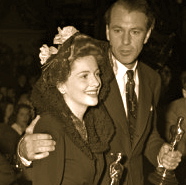
Academy Award History
Each year, millions tune in to watch the Academy Awards. Over the decades, thousands of Oscar statuettes have been handed out to those who work in the film industry – from actors to directors and film editors. How much do we really know about the Academy Awards? The Academy Awards have a rich history that spans more than eight decades. The first official Academy Awards ceremony took place during a banquet held at Hollywood’s Roosevelt Hotel on May 16, 1929. This was by no means the type of Oscar ceremony we see today – less than 300 people were on hand. Each paid a whopping $5 for a ticket to the dinner. In 1927 and 1928, a total of 15 Oscar statuettes were handed out to winners in various categories. Actor Emil Jannings was the Academy’s first-ever Best Actor winner – he received the Oscar for performances in two films: ”The Last Command” and ”The Way of All Flesh.” And what about that golden statuette that all the winners get on Oscar night? The trophy has a rich history. It was originally designed by founding Academy of Motion Picture Arts and Sciences member and art director Cedric Gibbons. Gibbons came up with the statuette’s unique design: the “majestic image” shows a knight “plunging his sword into a reel of film.” The first Oscar statue, originally called the “Academy Award of Merit,” was hand-cast in bronze at a cost of $500. In 1939, the award was named the Oscar. Why is the statue called the “Oscar” now? The nickname’s origins aren’t exactly clear. Some claim that legendary actress Bette Davis dubbed the statuette the “Oscar” because the back of the trophy, specifically the backside, “reminded her of her husband, Harmon ‘Oscar’ Nelson.” Other theories say the first librarian of the Academy, Margaret Herrick, dubbed the statuette the Oscar “because it reminded her of her uncle Oscar.”
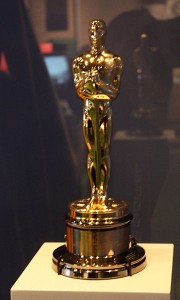 Cate Blanchett’s Oscar for playing Katharine Hepburn in The Aviator in 2004
Cate Blanchett’s Oscar for playing Katharine Hepburn in The Aviator in 2004
The Academy Awards, commonly known as The Oscars, is an annual American awards ceremony honoring achievements in the film industry. Winners are awarded the statuette, officially the Academy Award of Merit, that is much better known by its nickname Oscar. The awards, first presented in 1929 at the Hollywood Roosevelt Hotel, are overseen by the Academy of Motion Picture Arts and Sciences (AMPAS).
The awards ceremony was first televised in 1953 and is now seen live in more than 200 countries. The Oscars is also the oldest entertainment awards ceremony; its equivalents, the Golden Globes for foreign and domestic productions (film and television) the Emmy Awards for American television, the Tony Awards for theatre, and the Grammy Awards for music and recording, are modeled after the Academy Awards.
The 86th Academy Awards were held on March 2, 2014, at the Dolby Theatre in Los Angeles.
History
 Gary Cooper and Joan Fontaine holding their Oscars at the Academy Awards, 1942
Gary Cooper and Joan Fontaine holding their Oscars at the Academy Awards, 1942
The first Academy Awards were presented on May 16, 1929, at a private dinner at the Hollywood Roosevelt Hotel with an audience of about 270 people. The post Academy Awards party was held at the Mayfair Hotel. The cost of guest tickets for that night’s ceremony was $5. Fifteen statuettes were awarded, honoring artists, directors and other personalities of the filmmaking industry of the time for their works during the 1927–1928 periods; the ceremony ran for 15 minutes.
Winners had been announced to media three months earlier; however, that was changed in the second ceremony of the Academy Awards in 1930. Since then and during the first decade, the results were given to newspapers for publication at 11 pm on the night of the awards. This method was used until the Los Angeles Times announced the winners before the ceremony began; as a result, the Academy has since 1941 used a sealed envelope to reveal the name of the winners.
For the first six ceremonies, the eligibility period spanned two calendar years. For example, the 2nd Academy Awards presented on 3 April 1930, recognized films that were released between 1 August 1928 and 31 July 1929. Starting with the 7th Academy Awards, held in 1935, the period of eligibility became the full previous calendar year from 1 January to 31 December.
The first Best Actor awarded was Emil Jannings, for his performances in The Last Command and The Way of All Flesh. He had to return to Europe before the ceremony, so the Academy agreed to give him the prize earlier; this made him the first Academy Award winner in history. The honored professionals were awarded for all the work done in a certain category for the qualifying period; for example, Jannings received the award for two movies in which he starred during that period and Janet Gaynor later won a single Oscar for performances in three films. Since the fourth ceremony, the system changed, and professionals were honored for a specific performance in a single film. As of the 83rd Academy Awards ceremony held in 2011, a total of 2,894 Oscars have been given for 1,853 awards. A total of 302 actors have won Oscars in competitive acting categories or have been awarded Honorary or Juvenile Awards.
The 1939 film Beau Geste is the only movie starring as many as four Academy Award winners for Best Actor or Best Actress in a Leading Role (Gary Cooper, Ray Milland, Susan Hayward, Broderick Crawford) prior to any of the actors receiving the Best Actor Award.
Many movie historians believe that High Noon lost out for the 1952 Best Picture Award to The Greatest Show on Earth because the initial release of High Noon bared a panoramic view of modern downtown Los Angeles.
At the 29th ceremony, held on March 27, 1957, the Best Foreign Language Film category was introduced. Until then, foreign-language films were honored with the Special Achievement Award.
Oscar Statuette – Design
 Although there are eight other types of annual awards presented by the Academy (the Irving G. Thalberg Memorial Award, the Jean Hersholt Humanitarian Award, the Gordon E. Sawyer Award, the Academy Scientific and Technical Award, the Academy Award for Technical Achievement, the John A. Bonner Medal of Commendation, and the Student Academy Award) plus two awards that are not presented annually (the Special Achievement Award in the form of an Oscar statuette and the Honorary Award that may or may not be in the form of an Oscar statuette), the best known one is the Academy Award of Merit more popularly known as the Oscar statuette. Made of gold-plated britannium on a black metal base, it is 13.5 in (34 cm) tall, weighs 8.5 lb (3.85 kg) and depicts a knight rendered in Art Deco style holding a crusader’s sword standing on a reel of film with five spokes. The five spokes represent the original branches of the Academy: Actors, Writers, Directors, Producers, and Technicians.
Although there are eight other types of annual awards presented by the Academy (the Irving G. Thalberg Memorial Award, the Jean Hersholt Humanitarian Award, the Gordon E. Sawyer Award, the Academy Scientific and Technical Award, the Academy Award for Technical Achievement, the John A. Bonner Medal of Commendation, and the Student Academy Award) plus two awards that are not presented annually (the Special Achievement Award in the form of an Oscar statuette and the Honorary Award that may or may not be in the form of an Oscar statuette), the best known one is the Academy Award of Merit more popularly known as the Oscar statuette. Made of gold-plated britannium on a black metal base, it is 13.5 in (34 cm) tall, weighs 8.5 lb (3.85 kg) and depicts a knight rendered in Art Deco style holding a crusader’s sword standing on a reel of film with five spokes. The five spokes represent the original branches of the Academy: Actors, Writers, Directors, Producers, and Technicians.
In 1928, MGM‘s art director Cedric Gibbons, one of the original Academy members, supervised the design of the award trophy by printing the design on a scroll. In need of a model for his statuette, Gibbons was introduced by his future wife Dolores del Río to Mexican film director and actor Emilio “El Indio” Fernández. Reluctant at first, Fernández was finally convinced to pose nude to create what today is known as the “Oscar”. Then, sculptor George Stanley (who also did the Muse Fountain at the Hollywood Bowl) sculpted Gibbons’s design in clay and Sachin Smith cast the statuette in 92.5 percent tin and 7.5 percent copper and then gold-plated it. The only addition to the Oscar since it was created is a minor streamlining of the base. The original Oscar mold was cast in 1928 at the C.W. Shumway & Sons Foundry in Batavia, Illinois, which also contributed to casting the molds for the Vince Lombardi Trophy and Emmy Awards statuettes. Since 1983, approximately 50 Oscars are made each year in Chicago by Illinois manufacturer R.S. Owens & Company. The award weigh 8.5 pounds (3.9 kg) each and take between three to four weeks to manufacture each statue.
In support of the American effort in World War II, the statuettes were made of plaster and were traded in for gold ones after the war had ended.
Naming
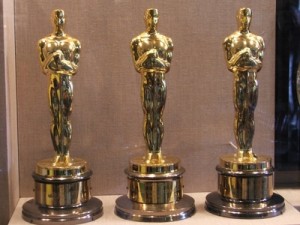 The origin of the name Oscar is disputed. One biography of Bette Davis claims that she named the Oscar after her first husband, band leader Harmon Oscar Nelson; one of the earliest mentions in print of the term Oscar dates back to a Time magazine article about the 1934 6th Academy Awards. Walt Disney is also quoted as thanking the Academy for his Oscar as early as 1932. Another claimed origin is that the Academy’s Executive Secretary, Margaret Herrick, first saw the award in 1931 and made reference to the statuette’s reminding her of her “Uncle Oscar” (a nickname for her cousin Oscar Pierce). Columnist Sidney Skolsky was present during Herrick’s naming and seized the name in his byline, “Employees have affectionately dubbed their famous statuette ‘Oscar’.” The trophy was officially dubbed the “Oscar” in 1939 by the Academy of Motion Picture Arts and Sciences. It may also have been named after the famous Irish playwright Oscar Wilde.
The origin of the name Oscar is disputed. One biography of Bette Davis claims that she named the Oscar after her first husband, band leader Harmon Oscar Nelson; one of the earliest mentions in print of the term Oscar dates back to a Time magazine article about the 1934 6th Academy Awards. Walt Disney is also quoted as thanking the Academy for his Oscar as early as 1932. Another claimed origin is that the Academy’s Executive Secretary, Margaret Herrick, first saw the award in 1931 and made reference to the statuette’s reminding her of her “Uncle Oscar” (a nickname for her cousin Oscar Pierce). Columnist Sidney Skolsky was present during Herrick’s naming and seized the name in his byline, “Employees have affectionately dubbed their famous statuette ‘Oscar’.” The trophy was officially dubbed the “Oscar” in 1939 by the Academy of Motion Picture Arts and Sciences. It may also have been named after the famous Irish playwright Oscar Wilde.
Ownership of Oscar Statuettes
Since 1950, the statuettes have been legally encumbered by the requirement that neither winners nor their heirs may sell the statuettes without first offering to sell them back to the Academy for US$1. If a winner refuses to agree to this stipulation, then the Academy keeps the statuette. Academy Awards not protected by this agreement have been sold in public auctions and private deals for six-figure sums. In December 2011, Orson Welles‘ 1941 Oscar for Citizen Kane (Best Original Screenplay) was put up for auction, after his heirs won a 2004 court decision contending that Welles did not sign any agreement to return the statue to the Academy. On December 20, 2011 it sold in an online auction for US$861,542.
While the Oscar is owned by the recipient, it is essentially not on the open market. Michael Todd‘s grandson tried to sell Todd’s Oscar statuette to a movie prop collector in 1989, but the Academy won the legal battle by getting a permanent injunction. Although some Oscar sales transactions have been successful, some buyers have subsequently returned the statuettes to the Academy, which keeps them in its treasury.
Nomination
Since 2004, Academy Award nomination results have been announced to the public in late January. Prior to that, the results were announced in early February.
Voters
The Academy of Motion Picture Arts and Sciences (AMPAS), a professional honorary organization, maintains a voting membership of 5,783 as of 2012.
Academy membership is divided into different branches, with each representing a different discipline in film production. Actors constitute the largest voting bloc, numbering 1,311 members (22 percent) of the Academy’s composition. Votes have been certified by the auditing firm Pricewaterhouse Coopers (and its predecessor Price Waterhouse) for the past 73 annual awards ceremonies.
All AMPAS members must be invited to join by the Board of Governors, on behalf of Academy Branch Executive Committees. Membership eligibility may be achieved by a competitive nomination or a member may submit a name based on other significant contribution to the field of motion pictures.
 New membership proposals are considered annually. The Academy does not publicly disclose its membership, although as recently as 2007 press releases have announced the names of those who have been invited to join. The 2007 release also stated that it has just under 6,000 voting members. While the membership had been growing, stricter policies have kept its size steady since then.
New membership proposals are considered annually. The Academy does not publicly disclose its membership, although as recently as 2007 press releases have announced the names of those who have been invited to join. The 2007 release also stated that it has just under 6,000 voting members. While the membership had been growing, stricter policies have kept its size steady since then.
In 2012, the results of a study conducted by The Los Angeles Times was published which revealed the demographic breakdown of approximately 88% of AMPAS’ voting membership. Of the 5,100+ active voters confirmed, 94% were Caucasian, 77% were male, and 54% were found to be over the age of 60. 33% of voting members are former nominees (14%) and winners (19%).
In May 2011, the Academy sent a letter advising its 6,000 or so voting members that an online system for Oscar voting will be implemented in 2013.
Rules
 According to Rules 2 and 3 of the official Academy Awards Rules, a film must open in the previous calendar year, from midnight at the start of 1 January to midnight at the end of 31 December, in Los Angeles County, California, to qualify (except for the Best Foreign Language Film). For example, the 2009 Best Picture winner, The Hurt Locker, was actually first released in 2008, but did not qualify for the 2008 awards as it did not play its Oscar-qualifying run in Los Angeles until mid-2009, thus qualifying for the 2009 awards.
According to Rules 2 and 3 of the official Academy Awards Rules, a film must open in the previous calendar year, from midnight at the start of 1 January to midnight at the end of 31 December, in Los Angeles County, California, to qualify (except for the Best Foreign Language Film). For example, the 2009 Best Picture winner, The Hurt Locker, was actually first released in 2008, but did not qualify for the 2008 awards as it did not play its Oscar-qualifying run in Los Angeles until mid-2009, thus qualifying for the 2009 awards.
Rule 2 states that a film must be feature-length, defined as a minimum of 40 minutes, except for short subject awards, and it must exist either on a 35 mm or 70 mm film print or in 24 frame/s or 48 frame/s progressive scan digital cinema format with native resolution not less than 1280×720.
Producers must submit an Official Screen Credits online form before the deadline; in case it is not submitted by the defined deadline, the film will be ineligible for Academy Awards in any year. The form includes the production credits for all related categories. Then, each form is checked and put in a Reminder List of Eligible Releases.
In late December ballots and copies of the Reminder List of Eligible Releases are mailed to around 6000 active members. For most categories, members from each of the branches vote to determine the nominees only in their respective categories (i.e. only directors vote for directors, writers for writers, actors for actors, etc.). In all major categories, voters use an instant runoff voting ballot, with potential nominees rewarded in the single transferable vote tally for having strong supporters who rank them first. There are some exceptions in the case of certain categories, like Foreign Film, Documentary and Animated Feature Film, in which movies are selected by special screening committees made up of members from all branches. In the special case of Best Picture, all voting members are eligible to select the nominees for that category. Foreign films must include English subtitles, and each country can submit only one film per year.
The winners are then determined by a second round of voting in which all members are then allowed to vote in most categories, including Best Picture.
Ceremony – Telecast
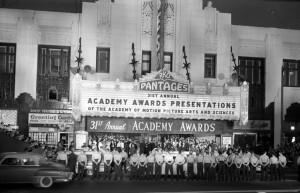 31st Academy Awards Presentations, Pantages Theater, Hollywood, 1959
31st Academy Awards Presentations, Pantages Theater, Hollywood, 1959
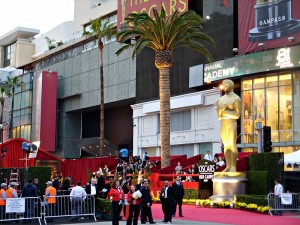 81st Academy Awards Presentations, Dolby Theatre, Hollywood, 2009
81st Academy Awards Presentations, Dolby Theatre, Hollywood, 2009
The major awards are presented at a live televised ceremony, most commonly in late February or early March following the relevant calendar year, and six weeks after the announcement of the nominees. It is the culmination of the film awards season, which usually begins during November or December of the previous year. This is an elaborate extravaganza, with the invited guests walking up the red carpet in the creations of the most prominent fashion designers of the day. Black tie dress is the most common outfit for men, although fashion may dictate not wearing a bow-tie, and musical performers sometimes do not adhere to this. (The artists who recorded the nominees for Best Original Song quite often perform those songs live at the awards ceremony, and the fact that they are performing is often used to promote the television broadcast).
The Academy Awards is televised live across the United States (excluding Hawaii; they aired live in Alaska starting in 2011 for the first time since 1996), Canada, the United Kingdom, and gathers millions of viewers elsewhere throughout the world. The 2007 ceremony was watched by more than 40 million Americans. Other awards ceremonies (such as the Emmys, Golden Globes, and Grammys) are broadcast live in the East Coast but are on tape delay in the West Coast and might not air on the same day outside North America (if the awards are even televised). The Academy has for several years claimed that the award show has up to a billion viewers internationally, but this has so far not been confirmed by any independent sources. The Awards show was first televised in 1953, on NBC, which continued to broadcast the event until 1960 when the ABC Network took over, televising the festivities through 1970, after which NBC resumed the broadcasts. ABC once again took over broadcast duties in 1976 and it is under contract to do so through the year 2020.
After more than 60 years of being held in late March or early April, the ceremonies were moved up to late February or early March starting in 2004 to help disrupt and shorten the intense lobbying and ad campaigns associated with Oscar season in the film industry. Another reason was because of the growing TV ratings success of the NCAA Men’s Division I Basketball Championship, which would cut into the Academy Awards audience. The earlier date is also to the advantage of ABC, as it now usually occurs during the highly profitable and important February sweeps period. Some years, the ceremony is moved into early March in deference to the Winter Olympics. Another reason for the move to late February and early March is to avoid the awards ceremony occurring so close to the religious holidays of Passoverand Easter, which for decades had been a grievance from members and the general public. Advertising is somewhat restricted, however, as traditionally no movie studios or competitors of official Academy Award sponsors may advertise during the telecast. The Awards show holds the distinction of having won the most Emmys in history, with 47 wins and 195 nominations.
After many years of being held on Mondays at 9:00 pm Eastern/6:00 p.m Pacific, in 1999 the ceremonies were moved to Sundays at 8:30 pm Eastern/5:30 pm Pacific. The reasons given for the move were that more viewers would tune in on Sundays, that Los Angeles rush-hour traffic jams could be avoided, and that an earlier start time would allow viewers on the East Coast to go to bed earlier. For many years the film industry had opposed a Sunday broadcast because it would cut into the weekend box office.
On 30 March 1981, the awards ceremony was postponed for one day after the shooting of President Ronald Reagan and others in Washington, D.C.
In 1993, an In Memoriam segment was introduced, honoring those who had made a significant contribution to cinema who had died in the preceding 12 months, a selection compiled by a small committee of Academy members. This segment has drawn criticism over the years for the omission of some names.
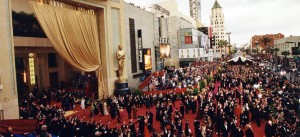 In terms of broadcast length, the ceremony generally averages three and a half hours. The first Oscars, in 1929, lasted 15 minutes. At the other end of the spectrum, the 2000 ceremony lasted four hours and four minutes. In 2010, the organizers of the Academy Awards announced that winners’ acceptance speeches must not run past 45 seconds. This, according to organizer Bill Mechanic, was to ensure the elimination of what he termed “the single most hated thing on the show” – overly long and embarrassing displays of emotion.
In terms of broadcast length, the ceremony generally averages three and a half hours. The first Oscars, in 1929, lasted 15 minutes. At the other end of the spectrum, the 2000 ceremony lasted four hours and four minutes. In 2010, the organizers of the Academy Awards announced that winners’ acceptance speeches must not run past 45 seconds. This, according to organizer Bill Mechanic, was to ensure the elimination of what he termed “the single most hated thing on the show” – overly long and embarrassing displays of emotion.
The Academy has contemplated about moving the ceremony even further back into January, citing TV viewers’ fatigue with the film industry’s long awards season. However, such an accelerated schedule would dramatically decrease the voting period for its members, to the point where some voters would only have time to view the contending films streamed on their computers (as opposed to traditionally receiving the films and ballots in the mail). Also, a January ceremony would have to compete with National Football League playoff games.

